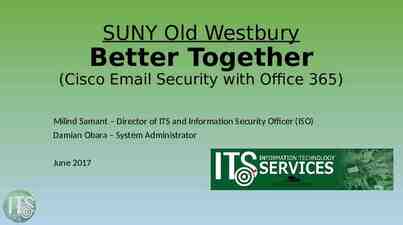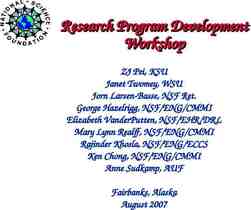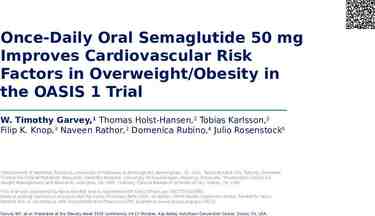TRAVEL SERVICES TRAINING
24 Slides4.24 MB

TRAVEL SERVICES TRAINING

LEARNING OBJECTIVES Discuss entire travel process from PRIOR Approval to Reimbursement Tools to reduce cost for travel related expenses and avoid use of personal resources Outline methods of payments for travel related expenses Review travel related policies, regulations and WSU procedures Procedure for preparing and processing TEV

TRAVEL PROCESS

APPROVAL TO TRAVEL PRIOR approval is required for ALL official University travel in order for the traveler to be eligible to TRAVEL and to be REIMBURSED – BPPM 95.05 Required written approval for official WSU travel - Travel Authority (TA) form A dean, director, chair or authorized University official must personally sign TA Indicates approval of the Travel Plan The department must retain the approved TA in departmental files The TA is not required to be routed to Travel or AP unless: A Travel Advance is requested OR Conference Registration is to be paid in Advance Employee in-state travel allows for VERBAL approval except when: Requesting an exception to policy, and/or Travel is partially or fully funded by a THIRD party

BOOKING TRAVEL Departments/Travelers may book through the following: Travel Agency Online Agency Directly with a Vendor Ensure the authorized travel plan is the most ECONOMICAL and ADVANTAGEOUS to the State The traveler is responsible for exercising prudent judgment when making travel arrangements

COST SAVINGS – STATE CONTRACTED RATES Take advantage of cost savings through WSU’s various State contracts: EasyBiz: booking travel on Alaska Airlines or Horizon Air State contracted fares Avoid third-party booking fees Earn Alaska Airline Mileage Plan miles for the State agency The traveler can also accumulate their own frequent flyer miles SWABIZ: booking travel on Southwest Airlines State contracted fares No change fees, bags fly free Enterprise/National Rent-A-Car: contracted rental car rates NASPO ValuePoint Travel Center: over 11,000 lodging facilities that will honor per diem rates

CTA – METHODS OF PAYMENT Central Travel Account (CTA): A Visa ghost card account—used by departments to purchase AIRFARE, BUS AND RAIL FARES Advantages: Personal resources do not have to be used for business related travel expenses Centralizes the booking process – allows for easier reconciliation Budgets are charged during the reconciliation process How to get a CTA account? Apply by sending a memo to Travel Services Ensuring CTA compliance: Maintain CTA log sheet with supporting documents Timely on-line reconciliation : JPMC PaymentNet ONLY allowed transactions: air, rail or bus fare

TRAVEL CARD– METHODS OF PAYMENT Corporate Travel Card: A personal liability Visa card – issued to WSU employees and ONLY to be used for WSU travel related expenses How to apply for a Travel Card? MUST be a WSU employee and expected to take at least ONE business trip per year Complete Travel Charge Card Application AND Cardholder’s Agreement Forms are located: https://travel.wsu.edu Submit signed forms to Travel Services – allow 2-3 weeks for processing Prohibited Purchases – any personal items and/or non-official travel related expenses Allowable Purchases -- meals, hotels, car rentals, taxi, baggage fees, etc. Upon returning from a trip, the traveler is responsible for the following: Completing a TEV to be sent to Travel for processing Paying the card balance in FULL when reimbursement is received – partial payments are prohibited

DIRECT TO VENDOR – METHODS OFarePAYMENT Vendor invoices WSU directly – payments processed through Travel Services Requires original signature and budget coding – TA# is used for payment reference Document business purpose and lodging exception rule (if applicable) Direct Vendor payments are ONLY allowed for the following: Non-employee car rentals Non-employee lodging Conference registrations Contractual lodging agreements are paid by the AP Contracts Desk Requires original signature and budget coding – C# is used for payment reference Exceptions for WSU Employee Lodging Direct Bills – see BPPM 95.06 Allowable when WSU employees accompany non-employees or students OR When five or more WSU employees book a block of rooms

PURCHASING CARD – METHODS OF PAYMENT P-Card: A corporate backed Visa card – available for faculty and staff and restricted to WSU business purchases only. The P-card can ONLY be used for the following travel related expenses: Non-employee travel expenses, except airfare (use CTA) and rental cars (Direct Bill thru Enterprise) Conference registration fees Washington “Go-Pass” fees For Purchasing Card policy exception requests related to Travel: Contact [email protected]

TRAVEL ADVANCES – METHODS OFandPAYMENT Travel Advances are approved processed through Travel Services – BPPM 95.05 Who qualifies for a Travel Advance? WSU employees in travel status for more than 14 days AND with no outstanding advances How to get a Travel Advance? Complete and submit a signed Travel Authority to Travel Services (zip: 1025) Must be signed by department head or designee, expenditure authority and traveler Allow 10 business days prior to the trip start dart for processing Contact the Travel Manager to request any exceptions to the Travel Advance policy If the exception is approved – the advance must be issued on 17A funds Advances cannot be issued more than 30 days before the trip start date

TRAVEL ADVANCES - CONT. Determining the Advance Amount Amount should be equal to or less than the total per diem allowance (lodging & meals) for the number of days in Travel Status Example:

TRAVEL ADVANCES - CONT. Clearing a Travel Advance – Travel advances are cleared with the submission of a TEV substantiating the expenses, and if applicable, the recovery of any portion that was not expensed. Tax Implications WSU follows an accountable plan as outlined in IRS Regulation 463 Travel advances must be substantiated and cleared within 120 days of the advance date If these conditions are not met, the applicable amount will be reported to Payroll Services, Payroll will withhold appropriate taxes based on the traveler’s W4 allowances The taxable amount will be reported as taxable income in Box 1 of the traveler’s W-2

PERSONAL RESOURCES – METHODS OF PAYMENT Personal Resources i.e. debit/credit card can be used for all employee and non-employee travel related expenses Upon completion of the trip: Submit a TEV/Expense reimbursement with applicable receipts and business purpose

TRAVEL STATUS Travel status begins when the traveler leaves their official station or residence on the way to a temporary duty station While in travel status, travelers need to keep the following receipts: Lodging (showing 0 balance) Transportation (i.e. airfare, rental car, etc.) Allowable miscellaneous travel expenses in excess of 50

Lodging ALLOWABLE EXPENSES Reimbursed at actual cost up toe daily maximum lodging rage Travelers must use a commercial lodging facility Shared venue lodging (i.e. AirBnB, VRBO, etc.) are allowable per WSU policy Lodging within 50 miles of official residence/station is not reimbursable Meals Reimbursed at the meal rate in effect at time of travel for the location Location for overnight trips is based on where the traveler sleeps (effective 1/1/2019) Single Day Trips – if 11hour rule is met, meals are considered taxable income Defined Meal Period – traveler must be in travel status for the entire meal period (effective 1/1/2019 Breakfast: 7-9am Lunch: 12-2pm Dinner: 5-7pm

UNALLOWABLE EXPENSES Personal expenses and expenses non essential to official state business are NOT reimbursable

TEV PREPARATION All WSU employees seeking reimbursement must utilize the E-forms system User Guides: http://public.wsu.edu/ forms/eforms.html Best practice is to have one TEV per trip/per traveler In group travel, each traveler should pay for their own travel related expenses Prepare a TEV for all travel related expenses to: Claim reimbursement Account for travel advances Account for travel supported by 3 rd parties

TEV PREPARATION Upon returning from a trip, the traveler is responsible for submitting required receipts and other pertinent details (i.e. time frame) Trip start/end date Primary destination Business purpose of the trip Complete the “Travel Details” section to include justification of an expense or request an exception to policy The traveler and authorized personnel sign the completed TEV, certifying and approving the travel expenses

TEV PREPARATION Tax implications, IRS Publication 463 (effective 1/1/2019) The TEV must be submitted within 60 days of the trip end date If not, the expenses will be taxed as ordinary income on the traveler’s W2 Per IRS regulation and as part of WSU’s accountable plan Third-party funded trips require a TEV to be submitted Provide additional documentation to support reimbursement Travel Advances Must be cleared within 120 days of the advance paid date If not, the advance will taxed as ordinary income on the traveler’s W2

TEV PROCESSING TEV’s are processed by Central based on the Last Name of the traveler TEV’s are processed within 10 business days of a properly competed TEV If claimant’s do not have a WSU ID#, additional processing time is needed Travel staff conducts a TEV audit based on the following:

PAYMENT TIMING In E-forms there is a 2-day lag from finalized TEV to payment schedule date Direct Deposit: deposited 2-3 business days after payment scheduled date Check: allow 5-7 business days to receive check Wires (international individuals): same day funding

FAQ’S Can a traveler be reimbursed for? Seat upgrades: No, this is a personal preference item Travel insurance/protection: No, this is a personal preference item Flight change fees: Yes but only with proper business justification on TEV Airfare purchased with miles: No, this would be personal cash gain for the traveler Rental car upgrade: No, this is a personal preference item What if I am in an accident or experience damage to my personal vehicle while on a WSU business trip? When using your own personal vehicle, WSU is not responsible for any loss or damage Personal vehicle insurance would be primary insurance coverage Specific questions should be addressed to Risk Management Other FAQ’s -- Discussion

THANK YOU!






